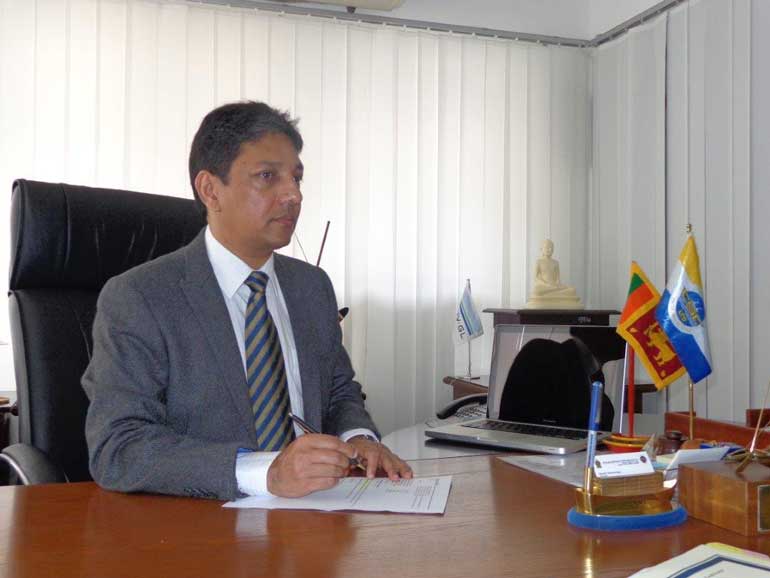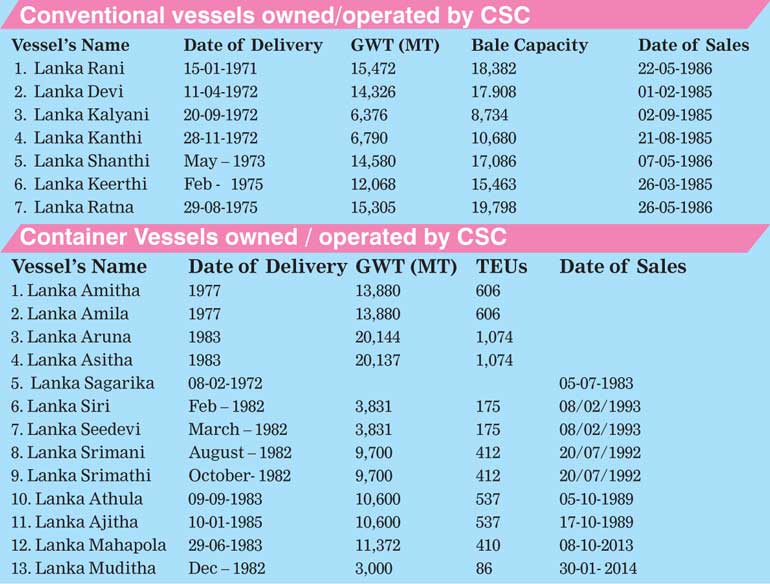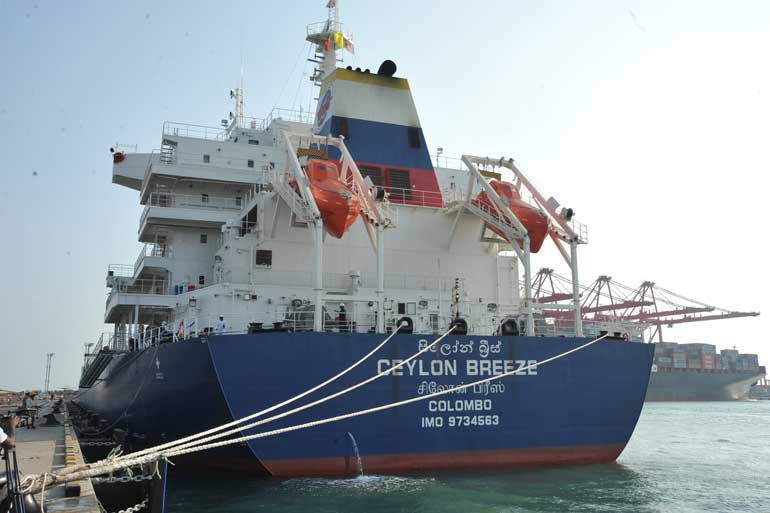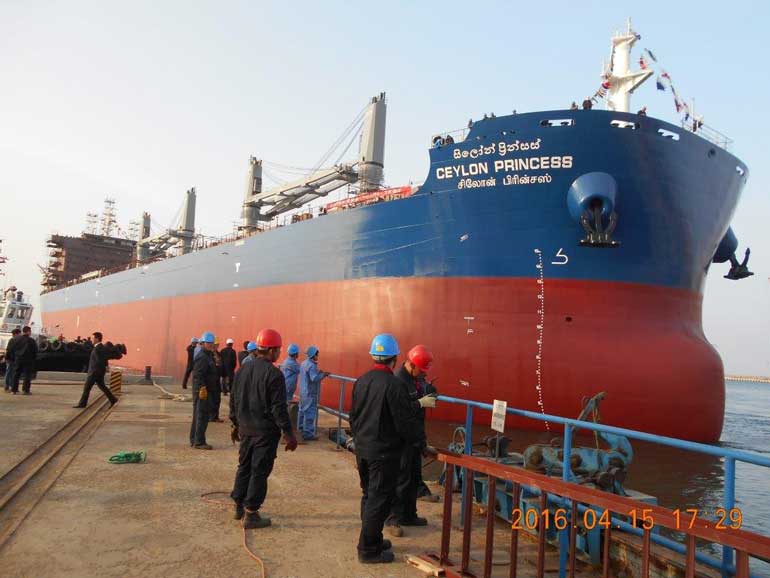Friday Jan 10, 2025
Friday Jan 10, 2025
Monday, 6 June 2016 00:00 - - {{hitsCtrl.values.hits}}

Historical Highlights
Inception and the early years from 1971 – 1980
Ceylon Shipping Corporation (CSC) was established by Parliament as the National Carrier of Sri Lanka through a special Act 11 of 6 June 1971.

CSC Fleet of vessels
‘Lanka Rani’ was the first vessel commissioned by CSC in 1971. This break- bulk conventional vessel was deployed in exporting of rubber to China and importing of rice from there under the Rubber/Rice Bilateral Agreement between Sri Lanka and China. By 1985, CSC owned a fleet of nine second-hand vessels (eight conventional and one tanker purchased in 1974). During this period Ceylon Port Services Ltd. was reactivated as the ship chandler of CSC’s vessels.
Government’s backup to the Infant National Carrier
CSC was supported through the export cargo allocation system for CSC vessels executed through the Central Freight Bureau (CFB). In addition the preference for transport of Government sector import cargo was given to CSC at competitive freight rates since 1983.
CSC operated liner services in the main routes from Colombo to Europe, China, Karachi and Middle East. Major export cargoes carried were tea, rubber, coconut and coconut products. Australia, South Africa, West and East South America were catered in collaboration with other lines.
Moreover, CSC offered promotional freight rates as an encouragement for these industries in Sri Lanka which facilitated them immensely to be successful in their overseas trading activities. CSC as the ‘one-stop-shop’ for all shipping needs was able to render an excellent service to the Sri Lankan export fraternity.
CSC’s progress during 1980 to 1989
The Port of Colombo was containerised in the year 1980 prompting CSC to commence containerised operations in the same year. CSC operated 04 container liner services to UK and Continent, Far East, Arabian Gulf and Red Sea and entered in to a joint venture with Neptune Orient Lines (NOL) and it operated on the UK and North Europe routes. CSC was the first to commence containerised operations in the Indian Sub-Continent and supported containerisation of Sri Lanka Port Authority (SLPA), thereby setting the initial steps for Colombo port to function as the regional hub port. SLPA has already recognised CSC as the highest revenue contributor to the Port of Colombo in three consecutive years in 1989, 1990 and 1991.
The joint venture with NOL was discontinued in 1982 and operated UK/North Europe service with her own chartered three vessels of 668 TEU capacity of each. This service earned enormous revenue and CSC commissioned the fourth vessel to Bombay and Karachi to collect cargo for the return trip as well. During this period, ‘Lanka Mahapola’, with a capacity of 408, TEU was introduced to Red Sea service in 1983 and an additional vessel was introduced in 1985 to cover Singapore as well.
Further, Sri Lanka-Arabian Gulf service operated with 175 TEU vessels and South Asia Far East routes were covered by using another three vessels. It is also very vital to mention that, CSC could offer a car carrier service for importers with the collaboration of Mitsui OSK Line, Japan. CSC had joint services to USA with Maersk Line and United States Lines. Australian National Line joined with CSC to operate the Australia service and also a service to Colombia was launched in 1986 with the participation of Columbian National Line.
In addition, CSC was able to launch a shuttle service from Colombo to Karachchi, West Coast of India to Colombo and from the East Coast of India to Singapore. During the pre liberalisation era, the upward trend of CSC emerged herself at the peak level in South Asian Region and she was proud to be the National carrier of Sri Lanka. The monopoly, which was prevailing in Sri Lankan shipping industry created many advantages to the country in many aspects.
CSC Owned/Operate Vessels (From the inception)
Liberalisation in the shipping industry and its impacts to CSC (During 90s)
The shipping industry was fully liberalised by the Government of Sri Lanka in 1989/1990 and CSC was exposed to the highly competitive market conditions. However, only the Europe service was allowed one year grace period for CSC to be steady when facing the competition. In order to face the competition, in 1990 CSC incorporated a marketing arm namely Ceylon Shipping Agency Ltd. in the year 1990 the Europe Service was also fully liberalised and CSC had to operate in highly competitive open market conditions.
CSC was converted to a Government owned Company as Ceylon Shipping Corporation Limited (CSCL) in the year 1992 under the Conversion of Public Corporations and Government Owned Business Undertakings into Public Companies Act No 23 of 1987.
Unfortunately, CSC was unable to respond to that fierce competition whilst operating smaller ships when compared with the competition who enjoyed the benefit of economies of scale of new generation mega vessels operating round the world services. During this period CSC continuously recorded loss from her business activities. The Treasury granted financial assistance to overcome the financial instability of the Corporation. CSC market share in the Europe Service drastically declined.
Progress from 2000-2015 Coal Transportation
CSC was entrusted the transportation of coal to Lakvijaya power plant of Ceylon Electricity Board from its inception by a Cabinet decision. Presently to run all three generating units of the Power Station to generate 900 MW an approximately 2.2 million metric tons of coal is required.
For the first time with the close coordination of all the stakeholders and efficiency of the coal discharging facilities at the CEB’s jetty, CSC and Lanka Coal Company were able to transport 2.2 million MT of coal in the recently concluded Contract Year 2015/2016.
Progress of 2015 and beyond
CSC has introduced an innovative brand in its shipping and logistic services within Container liner Operations to offer tailor-made shipping and logistic solution to Government sector customers. It provides bountiful of opportunities at competitive rates in obtaining value added services beyond marginal levels depending on the cargo volume they ship with CSC.
New vessels owned by CSC
CSC’s first bulk vessels MV.Ceylon Breeze carrying a capacity of 63,000 MT DWT has been delivered on 30th January 2016 at AVIC Shipyard Wehai, China. Since, then the vessel was deployed in transportation of coal for the Lakvijaya Power Station with the least idling given the current over supply market conditions. Since the Monsoon started in May MV.Ceylon Breeze has been chartered out until the beginning of the next Contract Year 2016/17. The Vessel is presently loading Manganese Ore to Tianjin, China from the Port Elizabath, South Africa.
The Second vessel ‘MV.Ceylon Princess’ which is expected to commissioned for commercial operation in the first week of July 2016. She also will be engaged in transportation of coal to Lakvijaya Thermal Power Plant during the non- monsoon period.
CSC has signed a Commercial Management Contract with Wallem Commercial Services Ltd. which is a reputed management company for securing cargo/charter opportunities. The company was selected through a process of Expression of Interests.
Maritime Education
CSC has been providing essential sea training for Sri Lankan marine cadets of Maritime institutes in Sri Lanka on CSC owned vessels. It has been planned to accommodate 12 marine cadets from Government Maritime institutes onboard MV Ceylon Breeze, which is added to CSC fleet on 30th January 2016. Next batch of 12 cadets will be trained on MV. Ceylon Princess which is expected to be delivered in July 2016.
CSC with a Futuristic Maritime Agenda
CSC Chairman Shashi Dhanatunge has identified number of potential profitable projects for the Corporation in consultation with shipping experts at CSC. He is optimistic that those projects would be feasible and sustainable for CSC as those would be initiated at almost Zero cost to the State on Public Private Partnership basis under the guidance of Minister Arjuna Ranatunga.
1) Purchase of a Vessel (Tug) for the deployment at the Mooring Buoy for Maintenance and Emergency Response Work (MERW) on charter terms to CPC.
2) Operation of a warehouse for clearing of Unaccompanied Personal Baggage.
3) Owning and operating Self-Propelled Barges for lightering of Coal from Port of Puttalam to Lakvijaya Power Station from September 2016 onwards
4) Operating of Floating Bunker Storage
5) Transportation of crude oil
6) Employment of two new ships and refinancing strategy
7) Operating of Floating LNG and LPG storage and facilitating power generation
8) Operating Coastal Shipping Services around the island
9) Passenger Ferry Operation (Thalaimannar/Rameshwaram/Colombo/Tuticorin)
10) Cruise Operation (Cochin/Colombo/Male)
11) Promote Sri Lanka Flag under FOC
Dhanatunge believes that some of the identified projects could change the course of maritime sector in the island and in the region, where more emphases would be given to energy saving, environment friendly and efficient services at economical rates for shipping activities in partnership with some of the best in the business around the world.

